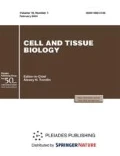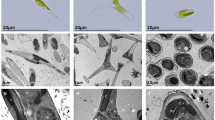Abstract
Dinoflagellates are an ecologically important group of aquatic single-cell eukaryotes. At present, relatively little is known about physiological features that determine the role of these protists in natural ecosystems. The lack of knowledge on the diversity, structure, and functioning of dinoflagellate ion channels significantly hampers the interpretation of physiological reactions and adaptations in these microorganisms. We performed the analysis of the translated transcriptome databases that belong to two strains of the dinoflagellate Prorocentrum minimum in order to identify the members of the voltage-gated cation channel superfamily. We found out that transcriptomes of these potentially toxic microorganisms contained the homologues of: 1—inwardly rectifying potassium channels (Kir), 2—voltage-gated potassium channels (Kv), 3—calciumactivated potassium channels (KCa), 4—cyclic nucleotide-gated channels (EAG and HCN/CNG), 5—TRPV and TRPP channels, 6—two-pore calcium channels TPC, 7—voltage-gated sodium (Nav) and calcium (Cav) channels, 8—and voltage-gated proton channels (Hv).
Similar content being viewed by others
Abbreviations
- a. a.:
-
amino acid residues
- Ank:
-
ankyrin domain
- BK:
-
large conductance calcium-activated potassium channel
- Cav :
-
Cav—voltage-gated calcium channel
- CNBD:
-
cyclic nucleotide-binding domain
- CNG:
-
cyclic nucleotide-gated channel
- EAG:
-
ether-a-go-go like channel
- HCN:
-
hyperpo-larization-activated cyclic nucleotide-gated channel
- K2P :
-
potassium leak channel
- Kir :
-
inwardly rectifying potassium channel
- Kv :
-
voltage-gated potassium channel
- NALCN:
-
sodium leak channel
- Nav :
-
voltage-gated sodium channel
- P-loop:
-
pore loop
- VSD:
-
voltage-sensitive domain
References
Adl, S.M., Simpson, A.G.B., Lane, C.E., Lukes, J., Bass, D., et al., The revised classification of eukaryotes, J. Eukaryot. Microbiol., 2012, vol. 59, pp. 429–493.
Arias-Darraz, L., Cabezas, D., Colenso, C.K., et al., A transient receptor potential ion channel in Chlamydomonas shares key features with sensory transduction-associated TRP channels in mammals, Plant Cell Online. C. tpc. 114.131862
Cai, X. and Clapham, D.E., Ancestral Ca2+ signaling machinery in early animal and fungal evolution, Mol. Bio. Evol., 2012, vol. 29, pp. 91–100.
Cai, X., Ancient origin of four-domain voltage-gated Na+ channels predates the divergence of animals and fungi, J. Membrane Biol., 2012, vol. 245, pp. 117–123.
Cembella, A.D., Chemical ecology of eukaryotic microalgae in marine ecosystems, Phycologia, 2003, vol. 42, pp. 420–447.
Craven, K.B. and Zagotta, W.N., CNG and HCN channels: two peas, one pod, Annu. Rev. Physiol., 2006, vol. 68, pp. 375–401.
DeCoursey, T.E., Voltage-gated proton channels, Cell. Mol. Life Sci., 2008, vol. 65, pp. 2554–2573.
Eckert, R. and Sibaoka, T., The flash-triggering action potential of the luminescent dinoflagellate Noctiluca, J. Gen. Physiol., 1968, vol. 52, pp. 258–282.
Figueroa, R.I., Cuadrado, A., Stüken, A., Rodríguez, F., and Fraga, S., Ribosomal DNA organization patterns within the dinoflagellate genus Alexandrium as revealed by FISH: life cycle and evolutionary implications, Protist, 2014, vol. 165, pp. 343–363.
Fujiu, K., Nakayama, Y., Iida, H., Sokabe, M., and Yoshimura, K., Mechanoreception in motile flagella of Chlamydomonas, Nat. Cell. Biol., 2011, vol. 13, pp. 630–632.
Hackett, J.D., Anderson, D.M., Erdner, D.L., and Bhattacharya, D., Dinoflagellates: a remarkable evolutionary experiment, Am. J. Bot., 2004, vol. 91, pp. 1523–1534.
Hall, T.A., BioEdit: a user-friendly biological sequence alignment editor and analysis program for Windows 95/98/NT, Nucl. Acids. Symp. Ser., 1999, vol. 41, pp. 95–98.
Hille, B., Ion Channels of Excitable Membranes, 3rd ed., Sunderland, MA, USA: Sinauer Associates, Inc., 2001.
Huang, K, Diener, D.R., Mitchell, A., Pazour, G.J., Witman, G.B., and Rosenbaum, J.L., Function and dynamics PKD2 in Chlamydomonas reinhardtii flagella, J. Cell Biol., 2007, vol. 179, pp. 501–514.
Jegla, T.J., Zmasek, C.M., Batalov, S., and Nayak, S.K., Evolution of the human ion channel set, Combinat. Chem. High Throughput Screening., 2009, vol. 12, pp. 2–23.
Kamykowski, D., Milligan, E.J., and Reed, R.E., Relationships between geotaxis/phototaxis and diel migration in autotrophic dinoflagellates, J. Plankton Res., 1998, vol. 20, no. 9, pp. 1781–1796.
Katoh, K. and Standley, D.M., MAFFT multiple sequence alignment software version 7: improvements in performance and usability, Mol. Biol. Evol., 2013, vol. 30, pp. 772–780.
Keeling, P.J., Burki, F., Wilcox, H.M., Allam, B., et al., The marine microbial eukaryote transcriptome sequencing project (MMETSP): illuminating the functional diversity of eukaryotic life in the oceans through transcriptome sequencing, PLoS Biol., 2014, vol. 12, p. e1001889.
Krutetskaya, Z.I., Lebedev, O.E., and Kurilova, L.S., Mekhanizmy vnutrikletochnoi signalizatsii (Mechanisms of Intracellular Signaling), St Petersburg: Izd. SPbGU, 2003.
Li, M., Yu, Y., and Yang, J., Structural biology of TRP channels, in Transient Receptor Potential Channels. Advances in Experimental Medicine and Biology, Dordrecht: Springer, 2011, vol. 704, pp. 1–23.
Liebeskind, B.J., Hillis, D.M., and Zakon, H.H., Evolution of sodium channels predates the origin of nervous systems in animals, Proc. Nat. Acad. Sci. USA, 2011, vol. 108, pp. 9154–9159.
Liebeskind, B.J., Hillis, D.M., and Zakon, H.H., Phylogeny unites animal sodium leak channels with fungal calcium channels in an ancient voltage-insensitive clade, Mol. Biol. Evol., 2012, vol. 29, pp. 3613–3616.
Martinac, B., Saimi, Y., and Kung, C., Ion channels in microbes, Physiol. Rev., 2008, vol. 88, pp. 1449–1490.
Molleman, A., Patch-Clamping: an Introductory Guide to Patch Clamp Electrophysiology, Chichester, West Sussex, UK: John Willey and Sons, Ltd., 2003.
Morrill, L.C. and Loeblich, A.R., III, Ultrastructure of the dinoflagellate Amphiesma, Int. Rev. Cytol., 1983, vol. 82, pp. 151–180.
Oami, K., Naitoh, Y., and Sibaoka, T., Distribution of ion channels in the membrane of the dinoflagellate Noctiluca miliaris, J. Exp. Biol., 1990, vol. 150, pp. 473–478.
Okolodkov, Yu.B., Dinoflagellata, in Protisty: rukovodstvo po zoologii (Protists: Guide Book in Zoology), St Petersburg: Tov. Nauch. Izd. KMK, 2011, vol. 3, pp. 7–94.
Okonechnikov, K., Golosova, O., Fursov, M., and the UGENE team, Unipro UGENE: a unified bioinformatics toolkit, Bioinformatics, 2012, vol. 28, pp. 1166–1167.
Pearson, W.R., An introduction to sequence similarity (“homology”) searching, Curr. Protoc. Bioinform., 2013. DOI: 10.1002/0471250953.bi0301s42
Pozdnyakov, I. and Skarlato, S., Dinoflagellate Amphiesma at different stages of the life cycle, Protistology, 2012, vol. 7, pp. 108–115.
Pozdnyakov, I., Matantseva, O., Negulyaev, Y., and Skarlato, S., Obtaining spheroplasts of armored dinoflagellates and first single-channel recordings of their ion channels using patch-clamping, Mar. Drugs, 2014, vol. 12, pp. 4743–4755.
Raikov, I.B., The dinoflagellate nucleus and chromosomes: mesokaryote concept reconsidered, Acta Protozool., 1995, vol. 34, pp. 239–247.
Single-Channel Recording, 2nd ed., Sakmann, B. and Neher, E., Eds., New York, Dordreht, Heildelberg, London: Springer-Science and Business Media., 2009.
Smith, S.M.E., Morgan, D., Musset, B., Cherny, V.V., Place, A.R., Hastings, J.W., and DeCoursey, T.E., Voltagegated proton channel in a dinoflagellate, Proc. Nat. Acad. Sci. USA, 2011, vol. 108, pp. 18162–18167.
Soyer-Gobillard, M.-O., Gillet, B., Geraud, M.-L., and Bhaud, Y., Dinoflagellate chromosome behavior during stages of replication, Int. Microbiol., 1999, vol. 2, pp. 93–102.
Taylor, A.R., Charchri, A., Wheeler, G., Goddard, and Brownlee, C., A Voltage-gated H+ channel underlying pH homeostasis in calcifying coccolithophores, PLoS Biol., 2011, vol. 9, p. e1001085.
Vandenberg, J.I., Perry, M.D., Perrin, M.J., Mann, S.A., Ke, Y., and Hill, A.P., hERG K+ channels: structure, function, and clinical significance, Physiol. Rev., 2012, vol. 92, pp. 1393–1478.
Yu, F.H., Yarov-Yarovoy, V., Gutman, G.A., and Catterall, W.A., Overview of molecular relationships in the voltagegated ion channel superfamily, Pharmacol. Rev., 2005, vol. 57, pp. 387–395.
Zefirov, A.L. and Sidtikova, M.A., Ionnye kanaly vozbudimoi kletki (struktura, funktsiya, patologiya) (Ion Channels of an Excitable Cell (Structure, Function, and Pathology)), Kazan: Art-cafe, 2010.
Author information
Authors and Affiliations
Corresponding author
Additional information
Original Russian Text © I.A. Pozdnyakov, S.O. Skarlato, 2015, published in Tsitologiya, 2015, Vol. 57, No. 7, pp. 533–543.
Rights and permissions
About this article
Cite this article
Pozdnyakov, I.A., Skarlato, S.O. Analysis of the dinoflagellate Prorocentrum minimum transcriptome: Identifying the members of the voltage-gated cation channel superfamily. Cell Tiss. Biol. 9, 483–492 (2015). https://doi.org/10.1134/S1990519X15060085
Received:
Published:
Issue Date:
DOI: https://doi.org/10.1134/S1990519X15060085




